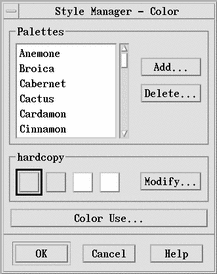Colors
You set your workspace colors through a color palette. The number of color buttons in the palette is determined by your display type and the Number of Colors selection.
The default is More Colors for Applications, which keeps the number of colors used on a high-color display to a minimum. To increase the number of color buttons on a high-color display, select More Colors for Desktop in the Number of Colors dialog box and restart the current session.
While you can't use more colors than your display allows, you can reduce the number of colors used by the desktop by choosing a lower-valued color usage.
For example, if you have a high-color display and have selected More Colors for Desktop but you want to run a color-rich application such as a computer-aided design (CAD) program, you should choose More Colors for Applications or Most Colors for Applications to decrease the number of colors that the desktop uses. The remaining colors are available for the CAD program.
Color Buttons
Your display type and the Number of Colors selection determine the number of color buttons that make up a palette. You will have two, four, or eight color buttons in the Color dialog box. The different color buttons in the palette control the colors used for different areas of the screen.
If you have eight color buttons, they will be used as follows (buttons numbered from left to right, top to bottom):
-
Active window borders
-
Inactive window borders
-
Switch for workspace 1 and every fourth additonal workspace (workspace 5, 9, ...)
-
Text and list areas
-
Main window background and switch for workspace 2 and every fourth additional workspace (workspace 8, 12, ...)
-
Dialog box background and menu bar and switch for workspace 3 and every fourth additional workspace (workspace 7, 11, ...)
-
Switch for workspace 4 and every fourth additional workspace (workspace 6, 10, ...)
-
Front Panel background
If you have four color buttons, they will be used as follows (buttons numbered from left to right):
-
Active window borders
-
-
Inactive window borders
-
Main window and dialog box backgrounds and menu bar
-
Front Panel background
-
-
Workspace switches and backgrounds
-
Text and list areas
If you have two color buttons, they will be used as follows (buttons numbered from left to right):
-
Active window borders
-
Everything else
To Select a Palette
-
Click the Style Manager Color control.
-
Select a palette from the Palettes list.

-
Click OK.
Workspace colors come from predefined color palettes. The Color dialog box lists the palettes that came with your system plus any palettes you have added.
To Modify an Existing Palette
-
Click the Style Manager Color control.
-
Select a palette in the Color dialog box.
-
Double-click a color button to open the Modify Color dialog box, or click a color button and then click Modify.
-
Adjust the settings for the level of red, green, blue, brightness, or hue by adjusting the corresponding slider.
The old and new color samples will be displayed in the upper left corner of the Modify Color dialog box.
-
Repeat steps 2-4 to modify another color button.
To Grab a Color from the Workspace
-
Click the Style Manager Color control.
-
Select a palette in the Color dialog box.
-
Double-click a color button to open the Modify Color dialog box, or click a color button and then click Modify.
-
Click Grab Color to display the grab pointer.
-
Move the pointer to an area of color on the screen that you want to grab.
-
Click to make that color the new color.
Note -This causes the desktop to use one more color so applications have one fewer color available to them.
To Create a Custom Palette
You can create your own palette by copying and modifying an existing palette.
-
Click the Style Manager Color control.
-
Choose Add in the Color dialog box.
-
Type the new palette name and click OK in the Add Palette dialog box.
-
Modify the palette.
-
Click OK in the Color dialog box.
Adding a palette makes a copy of the currently selected palette with a unique name. You then create your custom palette by modifying the copy and the original palette is not changed.
To Delete a Palette
-
Click the Style Manager Color control.
-
Select the palette from the Palettes list.
-
Click Delete.
-
Click OK in the Delete Palette dialog box.
When you delete a palette, Style Manager prefixes the name of the palette with a ~ and stores a copy in the HomeDirectory/.dt/palettes directory.
To Restore a Deleted Palette
-
Open a File Manager view showing HomeDirectory/.dt/palettes.
-
For system-supplied palettes, delete the file ~palette_name.dp.
For user-added palettes, rename the deleted palette from ~palette_name.dp to palette_name.dp.
-
Restart Style Manager (close, then reopen).
To Change the Number of Colors Used by the Desktop
-
Click the Style Manager Color control.
-
Click Number of Colors in the Color dialog box.
-
Select an option to set the number of colors used by the desktop.
See "Colors".
-
Click OK.
You must log out and back in for the change to take effect.
- © 2010, Oracle Corporation and/or its affiliates
